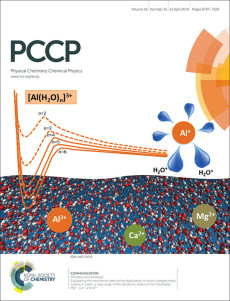‘Thirsty’ Metals Key to Longer Battery Lifetimes
Computations at NERSC show how multiply charged metal ions impact battery capacity
June 30, 2014
Contact: Kathy Kincade, +1 510 495 2124, kkincade@lbl.gov
Imagine a cell phone battery that lasted a whole week on a single charge. A car battery that worked for months between charges. A massive battery that stores the intermittent electricity from wind turbines and releases it when needed.
In all three cases, today’s batteries simply do not hold enough charge. Replacing lithium with other metals with multiple charges could greatly increase battery capacity. But first researchers need to understand how to keep multiply charged ions—ions that have gained or lost more than one electron—stable.
Research has shown that when a multiply charged aluminum or magnesium cation—a positively charged ion—encounters a single water molecule, the result can be explosive. The metal ion rips an electron from the water molecule, causing a molecular-level explosion, triggered by the Coulombic repulsion of the two positive charges on each fragment. But multiply charged metal ions exist in water in countless ways, such as the calcium ions in a chocolate milkshake.
Now, using supercomputers at the National Energy Research Scientific Computing Center (NERSC), a team of Pacific Northwest National Laboratory (PNNL) researchers determined that the paths that lead to either the hydrolysis of water or the creation of stable metal ion clusters peaceably surrounded by water. It comes down to the pH of the solution, the number of water molecules nearby and the energy needed to remove electrons from the metal, known as the ionization potential.
"When multiply charged metal ions interact with water, there are several reaction channels possible corresponding to different physical and chemical processes," said Sotiris Xantheas, who led the research at PNNL. "By understanding how the local environment stabilizes the charge on the metal, one can imagine using those multiply charged metals to increase the capacity of a battery."
This research was featured on the cover of the April 21, 2014, issue of Physical Chemistry Chemical Physics and in a special issue of Theoretical Chemistry Accounts.
"This paper describes an elegant use of computational modeling to understand a phenomena that is of fundamental importance in chemistry, yet has many practical applications as well," said Thomas H. Dunning, co-director of the Northwest Institute for Advanced Computing, which is operated by PNNL and the University of Washington.
More Accurate Computational Models
Numerous experiments have shown that multiple charged metal ions can generate hydrolysis products through the hydrolysis channel or metal-water clusters through the association channel, depending on the pH. Experiments, however, could not delve into "why" the different products appeared. By running accurate computational models on NERSC’s Edison, Hopper and Carver systems, Xantheas and his colleague Evangelos Miliordos calculated the different electronic states corresponding to those different channels for three metal ions—Al+3, Ca+2 and Mg+2—with several water molecules in the gas phase.
To accurately calculate the location and behavior of the electrons on these metal cation water clusters, the scientists computed all the states that led to the different channels. The hydrolysis channels, seen at low pH, were also computed for the alkaline earth dication (Mg2+, Ca2+, Sr2+, Ba2+) microsolvated clusters.
"We want to use other metals that have +2 or +3 oxidation states," said Xantheas. "This would double or triple the amount of charge that could be stored in a battery, but before this study, we had no insights on how the ions are either stabilized or destabilized when their local environment changes." NERSC supercomputers played a critical role in making this research possible, he added. "Several platforms were used (Edison, Hopper and Carver) in conjunction with NERSC-supported electronic structure software (MOLPRO)," he said.
The team found that each of the various metal ions require different numbers of water molecules to be stable as a microsolvated cluster. For example, the magnesium ion requires at least two water molecules for stability. For aluminum, four water molecules are needed. This stability is due to complex interactions between the ions and the water. The water cluster has an effective ionization potential; that is, the energy needed to pull an electron from a water cluster. The ionization potential increases as more water molecules are added. Eventually, at the right number of water molecules, the ionization potential of the water cluster gets larger than the corresponding ionization potential of the metal, preventing the removal of electrons from the water and creating stability for the metal-water cluster.
While these calculations required extensive computing time, the challenge is the analysis, the researchers noted. Both spent considerable time analyzing and refining the calculations.
"A lot of analysis is required to decide what the next step is. At every step you need to decide what the next step is in the process. What did you learn and where do you want to go?" said Miliordos, a postdoctoral fellow from the University of Athens who is working with Xantheas.
The researchers are now working to extend their computational protocol to other ions (such as Iron) and understand the speciation of multiply charged ions as a function of their coordination in an aqueous interface, Xantheas noted. Extending the methodology will allow the team to better understand the dynamic interactions occurring, eventually leading to better battery technologies.
This article was adapted from materials provided by PNNL.
About NERSC and Berkeley Lab
The National Energy Research Scientific Computing Center (NERSC) is a U.S. Department of Energy Office of Science User Facility that serves as the primary high performance computing center for scientific research sponsored by the Office of Science. Located at Lawrence Berkeley National Laboratory, NERSC serves almost 10,000 scientists at national laboratories and universities researching a wide range of problems in climate, fusion energy, materials science, physics, chemistry, computational biology, and other disciplines. Berkeley Lab is a DOE national laboratory located in Berkeley, California. It conducts unclassified scientific research and is managed by the University of California for the U.S. Department of Energy. »Learn more about computing sciences at Berkeley Lab.








